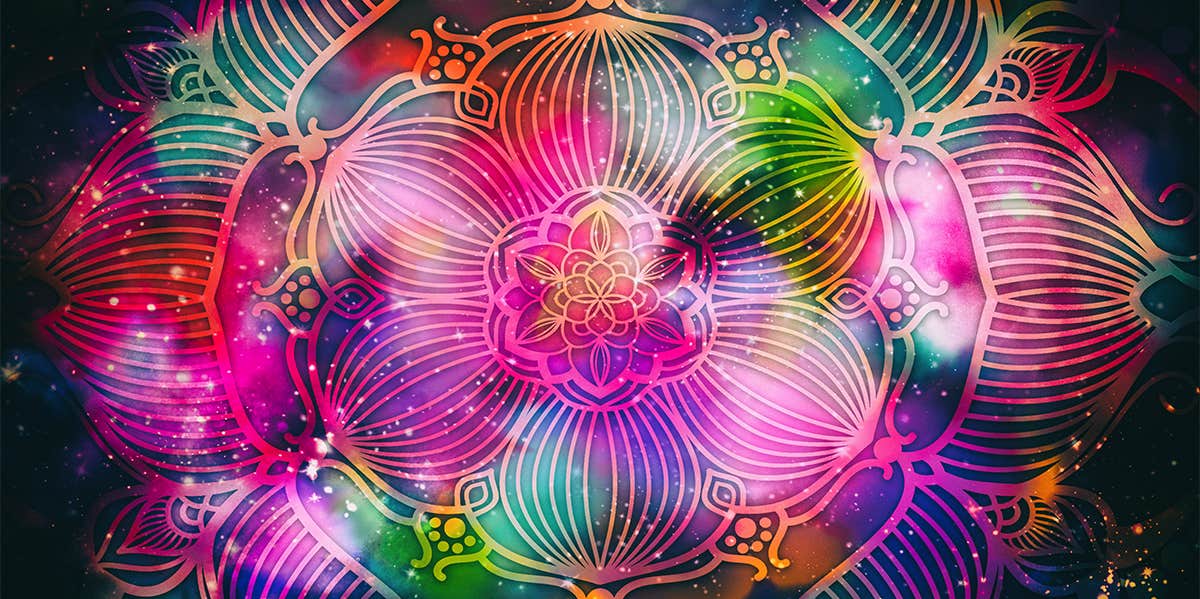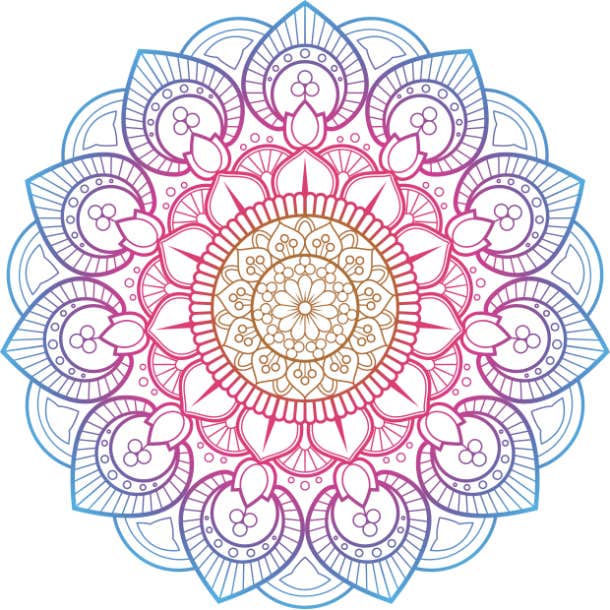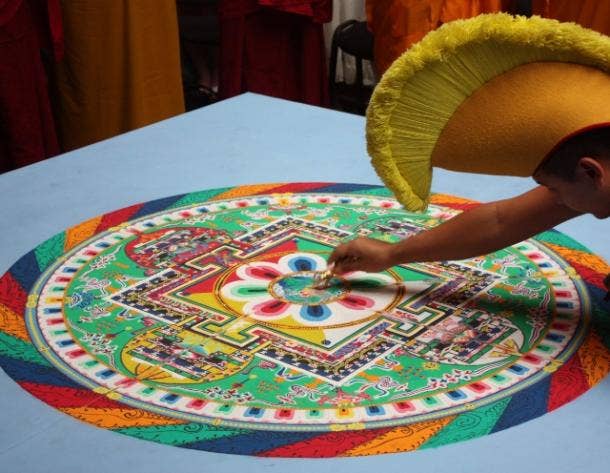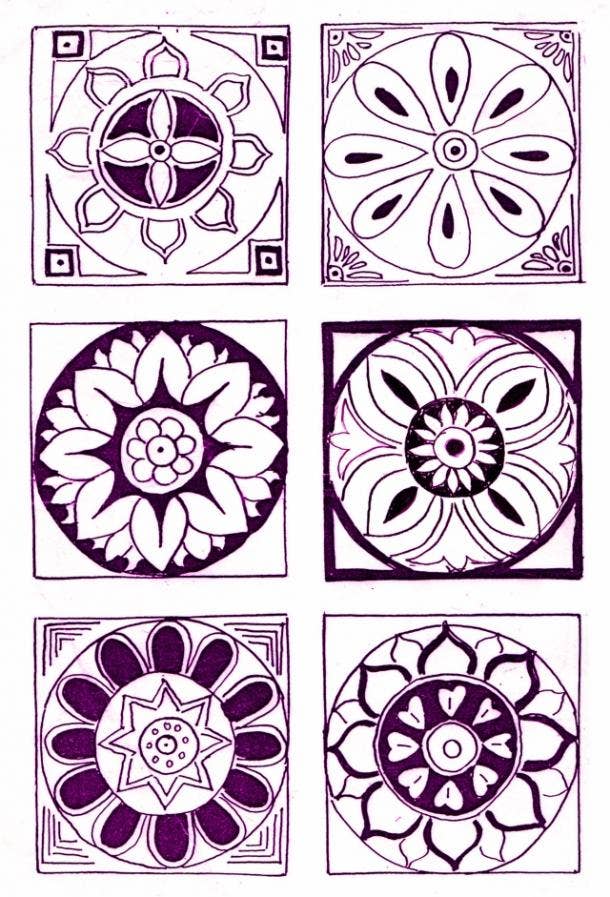
A path to spiritual enlightenment.
By Lindsey Matthews — Last updated on Aug 06, 2022
Photo: jakkaje879 / Shutterstock

Many of us have seen adult coloring books featuring beautiful mandalas to make our own, but what makes these shapes so incredibly unique? Why do we seem to be drawn to the patterns, and why does their structure provide so much peace?
Aside from being beautiful and nice to look at, the mandala holds historical meaning and incredibly spiritual symbolism.
What is a mandala?
A mandala is much more than just a page in a coloring book; mandalas are geometric symbols with a great deal of meaning and symbolism.
The word mandala comes from a Sanskrit word that loosely translates to "circle." Though mandalas are generally thought to be strategic designs with repeating shapes and patterns, they can also be more free-flowing and asymmetrical, drawn in both circles and squares.
Buddhists first to created the mandala and used it as a meditation tool to free themselves from the neverending cycle of death and rebirth. The mandala aids in finding enlightenment and healing during meditation, helping people to find peace once the meditation is complete.
RELATED: 27 Stunning Mandala Tattoos With Deep Meanings
In Buddhism, the mandalas contain squares and circles within the main circle itself. And each square and circle within the mandala holds its own meaning.
The circles are a representation of the cosmos, and the squares are symbolic of earthly levels. Each square and circle is considered a "level" to pass through to get into the center of the mandala.
Once you have reached the center of the mandala, you have gone from an ordinary mind to an enlightened mind. Finding your way to the center of the mandala is a symbol of finding your path in the universe.
 Photo: Yana Lesnik / Shutterstock
Photo: Yana Lesnik / Shutterstock
Where did the mandala originate?
The history of the mandala is traced back centuries, to the first known image of the mandala in the Rig Veda, an ancient Hindu text from the 1500–1000 BCE period. However, the mandala is actually a creation of Buddhism, which then spread to other countries throughout the years.
The founder of Buddhism, Siddhartha Gautama (Buddha), left Nepal to seek spiritual enlightenment through meditation, sharing his message throughout India. As his followers traveled the Silk Road, they spread the word of Buddhism, carrying mandalas with them in their practice.
The symbols eventually began appearing across Asia by the fourth century, spreading to Hinduism and other religions and cultures.
In more modern times, the mandala was introduced to the mainstream by psychologist Carl Jung, who saw the mandala as a reflection of the inner mind, or the Self. Jung claimed that creating mandalas allowed self-understanding, which led to higher consciousness.
Types of Mandalas & How to Use Them
Mandalas can be incredibly detailed and intricate, or plain and simple, but they all represent a spiritual journey. They can be created through yarn, paintings, drawings, or even with sand.
There are three types of mandalas: sand, healing, and teaching.
Sand Mandala
Sand mandalas are a meditation tool for focus and represent the impermanence of human life. The creation of the sand mandala is a tradition where sacred ceremonies are held; the ceremonies and building of the sand mandalas typically last for three days, and includes sand of different colors.
Rituals, such as dances and meditation teachings, are a core part of the ceremonies. Sand is placed in the center of the mandala and represents Buddha; the artist then works their way from the inside out, each layer representing a different Buddhist teaching.
At the end of the ceremonies, once the mandala is finished, the sand is collected in a jar, wrapped in silk, and released into water.
 Photo: GgvlaD / Wikimedia Commons
Photo: GgvlaD / Wikimedia Commons
Healing Mandala
Healing mandalas boost creativity, and are used specifically for meditation to achieve wisdom and concentration. These mandalas are meant to bring calm and increase intuition in the creator of the mandala.
Healing mandalas are used as a tool to release positive energy into the world for all who participate in the ceremonies. The mandala now lives within them forever as an experience that will carry on through their lives.
Teaching Mandala
The teaching mandala symbolizes the individual's cumulative learning experience. Once they have an understanding of design and creation, they can construct the mandala.
Every line, color or shape represents a specific aspect of the religious or philosophical system, and are meant to be symbolic images that "map out" the mind of the mandala's creator.
RELATED: What Is Karma And Is It Real? 3 Types Of Karma And How It Works
Mandalas In Art
The most common mandala designs include elephants, flowers, circles, and geometric shapes. Each design is a symbol of different spiritual aspects.
The elephant mandala represents power and strength. It can also symbolize a strong soul and is used most frequently in Buddhism.
The flower mandala stands for all life in the universe. The flower also aids in focus during meditation practices.
Circle mandalas are the most common design among religions and spiritual practices. The circle design is symbolic of finding ourselves and becoming whole.
Related Stories From YourTango:
Geometric mandalas are used to symbolize nature and the enlightenment of the human body. This means that we are a part of nature, and nature is a part of us.
 Photo: Hannoverscher / Wikimedia Commons
Photo: Hannoverscher / Wikimedia Commons
In our society, we see a lot of these designs every day on tapestries, tattoos, and even items as insignificant as notebooks for journaling. While it’s fine to appreciate the beauty and detail of mandalas, it’s also important that we educate ourselves on their meaning before hanging them up in our home.
For many religions, not just Buddhism and Hinduism, mandalas are considered sacred and are expected to be treated accordingly. We should use our interest in the designs as an opportunity to learn more about other cultures and religions. You may even want to practice mindful meditation rituals in alignment with your mandala.
A creative way to incorporate the true meaning of the mandala in your life could be to find one in a coloring book and fill it in with your favorite colors. While you’re filling in the colors, start from the outside and work your way in, focusing on each pattern as a relaxation technique.
Mandalas are a unique symbol of spiritual enlightenment and have become more and more common in our culture.
The next time you see someone with a mandala tattoo or tapestry, take the opportunity to teach them about its spiritual meaning. Then you can spread enlightenment by teaching others about the mandala and its sacred meaning.
RELATED: 40 Symbols Of Strength & Courage From Cultures Around The World
More for You:
Lindsey Matthews is a writer and contributor to YourTango. She writes primarily about relationships, entertainment and news, and pop culture.
